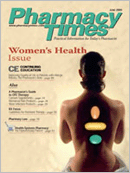Publication
Article
Pharmacy Times
A Pharmacist's Guide to OTC Therapy: Menstrual Pain Products
Author(s):
Painful menstruation (also known as dysmenorrhea), common in young females, occurs when menstrual periods cause a "crampy" abdominal pain that begins a few days, hours, or just prior to the onset of a menstrual period. For many women, this condition makes it difficult to perform normal duties in the household and in the workplace. Primary dysmenorrhea refers to pain that is unrelated to a medical condition, whereas secondary dysmenorrhea is a result of a medical condition such as endometriosis, pelvic inflammatory disease, or tumors. Pain may range from mild to severe and may be accompanied by nausea, vomiting, either diarrhea or constipation, or other symptoms (Table 1).
Some Causes of Menstrual Pain
The role of prostaglandins in the uterus has been linked to dysmenorrhea, which explains why prostaglandin inhibitors are effective in treating pain. Prostaglandin activity causes the uterus to contract and produces high levels in women with severe menstrual pain. The incidence of dysmenorrhea usually occurs in women in their late teens/early 20s, decreasing with age. The use of an intrauterine device for birth control, as well as the use of vaginal tampons, may aggravate menstrual pain. Lifestyle factors, such as smoking or drinking excessive amounts of alcohol, also may be linked to severe pain.
Initial Approach to Treatment
A physical evaluation is important to differentiate between functional menstrual pain and pain from other underlying diseases. Good nutrition, consisting of a well-balanced diet and foods high in complex carbohydrates, is important. Caffeine intake and foods high in sodium should be limited. Although caffeine is an effective diuretic in many formulations, it can interfere with sleep; salty foods can contribute to bloating. Exercise may prove to be beneficial, especially in alleviating mood disorders.
Certain vitamins, minerals, and herbal supplements are used to relieve some of the symptoms. Calcium (1200 mg/day) and magnesium (360 mg/day) may reduce cramping and fluid retention. Vitamin E (150-600 units/day) and evening primrose oil (500-3000 mg/day) have been shown to reduce breast tenderness associated with menstruation. Single-use heating wraps designed to provide heat for up to 8 hours also are indicated for the relief of minor menstrual cramps.
OTC Medications
Menstrual pain may be self-treated with a number of OTC products consisting of analgesics and/or analgesic- diuretic combinations (Table 2).
Analgesics
These products work best if they are taken when symptoms first occur and on a scheduled rather than "as-needed" basis. Mild-to-moderate pain usually responds to acetaminophen, which also is included in many popular combination OTC products. Because effective treatment of moderate-to-severe pain involves the inhibition of production and activity of prostaglandins, nonsteroidal anti-inflammatory drugs (NSAIDs), eg, ibuprofen and naproxen, may be recommended as good choices. Because of its side-effect profile, aspirin generally is not a first-line agent. NSAIDs can cause abdominal discomfort and nausea and should be taken with food. They are to be used with caution in patients with kidney disease, gastric ulcers, allergy to aspirin or to any other NSAIDs, and bleeding disorders.
Diuretics
Caffeine and pamabrom are diuretics that are included in many combination products for the relief of temporary weight gain and bloating. The role of pyrilamine, an antihistamine often listed as a diuretic, has been inconclusive.
Conclusion
Pharmacists should counsel patients on possible side effects of these OTC medications, as well as advising them about nondrug treatments. Most important, if menstrual pain disrupts quality of life to a great extent, occurs frequently, or is not relieved by OTC products, a health care provider should be consulted.







